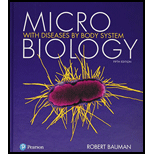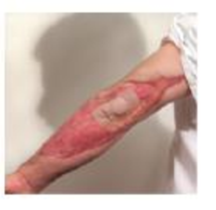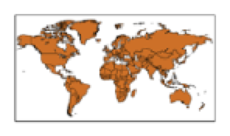
Necrotizing Fasciitis

Fever, chills, nausea, weakness, and general yuckiness. Carlos thought he was getting the flu. Further, he had pulled a cactus thorn from his arm the day before, and the tiny wound had swollen to a centimeter in diameter. It was red, extremely hot, and much more painful than such a puncture had a right to be. Everything was against him. He couldn’t afford to miss days at work, but he had no choice.
He shivered in bed with fever for the next two days and suffered more pain than he had ever experienced, certainly more than the time he broke his leg. Even more than passing a kidney stone. The red, purple, and black inflammation on his arm had grown to the size of a baseball. It was hard to the touch and excruciatingly painful. He decided it was time to call his brother to take him to the doctor. That decision saved his life.
Carlos’s blood pressure dropped severely, and he was unconscious by the time they arrived. The physician immediately admitted Carlos to the hospital, where the medical team raced to treat necrotizing fasciitis, commonly called “flesh-eating” disease. This reemerging disease is caused by group A Streptococcus, a serotype of Gram-positive bacteria also known as Streptococcus pyogenes. Group A strep invades through a break in the skin and travels along the fascia-the protective covering of muscles-producing toxins that destroy human tissues, affecting about 750 people each year in the United States.

By cutting away all the infected tissue; using high-pressure, pure oxygen to inhibit bacterial growth; and applying antimicrobial drugs to kill the bacterium, the doctors stabilized Carlos. After months of skin grafts and rehabilitation, he returned to work, grateful to be alive. (For more about necrotizing fasciitis, see pp.560-561.)
1. What color do cells of S. pyogenes appear after the
Want to see the full answer?
Check out a sample textbook solution
Chapter 4 Solutions
Microbiology with Diseases by Body System (5th Edition)
- Bruno, a 48-year-old businessman, presents at the emergency room with a 12-day history of headache, myalgia, nausea, and vomiting. Patient history reveals that Bruno is a consulting engineer for the Panama Canal. Prior to his latest trip, he failed to fill a prescription for prophylactic medication. However, according to his general physician's records, all his immunizations (e.g., hepatitis, flu) are up to date. His fever was 103° F (39° C) at the time of initial examination, but alternated with periods of extreme cold and cyanosis. A complete blood count was ordered, along with parasite examination, and urinalysis. The thin Giemsa film yielded the morphologic forms in the image below. What parasite (genus and species) do you suspect? What is the life stage for the parasite recovered from this blood sample? How did Bruno acquire this infection How should the physician order the blood collection for parasite examination in this case?arrow_forwardNeutropenic fever- identifications and antibiotics coveragearrow_forwardA 48-year-old businessman, presents at the emergency room with a 12-day history of headache, myalgia, nausea, and vomiting. Patient history reveals that the patient is a consulting engineer for the tropical area. On his latest trip, he failed to take his prophylaxis for malaria. According to his general physician’s records, all his immunizations are up to date. His fever was 39°C at the time of initial examination, but alternated with periods of extreme cold and cyanosis. A complete blood count was ordered, along with parasite examination and urinalysis. What parasite do you suspect? Which morphological factor will be important in deciding the species of this organism? Which morphological form you may observe in the peripheral blood of this patient? How did the patient contract this parasitic infection? Why this species can cause much more serious result than other species among this organism? Please list name of three parasites that lead to anemia as the main symptoms, and their…arrow_forward
- Patient X was rushed to a nearby hospital in Tuguegarao City after experiencing severe abdominal pain, persistent vomiting, marked change in temperature going from fever to hypothermia, restlessness, cold, clammy skin, and rapid, weak pulse. In addition, Patient X noted that she experienced high bouts of fever during the first week but has subsided. Small red spots or purple splotches can be seen on her skin, and she tested positive on the tourniquet test. According to her travel history, she recently visited Aklan and Negros Occidental Answer the following questions:4. Which of her symptoms indicate early signs of shock? Which of her symptoms point to hemorrhagic manifestations?5. Enumerate laboratory methods that can be used to diagnose the disease or detect the virus.6. How is the disease treated and controlled/prevented?arrow_forwardPatient X was rushed to a nearby hospital in Tuguegarao City after experiencing severe abdominal pain, persistent vomiting, marked change in temperature going from fever to hypothermia, restlessness, cold, clammy skin, and rapid, weak pulse. In addition, Patient X noted that she experienced high bouts of fever during the first week but has subsided. Small red spots or purple splotches can be seen on her skin, and she tested positive on the tourniquet test. According to her travel history, she recently visited Aklan and Negros Occidental Answer the following questions:1. Which disease is characterized by the symptoms experienced by Patient X? Correlate her medical information and travel history to the disease.2. Explain the pathology of the disease.3. Which virus could have caused the disease? How did she contract the virus?4. Which of her symptoms indicate early signs of shock? Which of her symptoms point to hemorrhagic manifestations?5. Enumerate laboratory methods that can be used…arrow_forwardPatient X was rushed to a nearby hospital in Tuguegarao City after experiencing severe abdominal pain, persistent vomiting, marked change in temperature going from fever to hypothermia, restlessness, cold, clammy skin, and rapid, weak pulse. In addition, Patient X noted that she experienced high bouts of fever during the first week but has subsided. Small red spots or purple splotches can be seen on her skin, and she tested positive on the tourniquet test. According to her travel history, she recently visited Aklan and Negros Occidental Kindly answer all the following questions:1. Which disease is characterized by the symptoms experienced by Patient X? Correlate her medical information and travel history to the disease.2. Explain the pathology of the disease.3. Which virus could have caused the disease? How did she contract the virus?arrow_forward
- Patient X was rushed to a nearby hospital in Tuguegarao City after experiencing severe abdominal pain, persistent vomiting, marked change in temperature going from fever to hypothermia, restlessness, cold, clammy skin, and rapid, weak pulse. In addition, Patient X noted that she experienced high bouts of fever during the first week but has subsided. Small red spots or purple splotches can be seen on her skin, and she tested positive on the tourniquet test. According to her travel history, she recently visited Aklan and Negros Occidental 4. Which of her symptoms indicate early signs of shock? Which of her symptoms point to hemorrhagic manifestations?5. Enumerate laboratory methods that can be used to diagnose the disease or detect the virus.6. How is the disease treated and controlled/prevented?arrow_forwardPatient X was rushed to a nearby hospital in Tuguegarao City after experiencing severe abdominal pain, persistent vomiting, marked change in temperature going from fever to hypothermia, restlessness, cold, clammy skin, and rapid, weak pulse. In addition, Patient X noted that she experienced high bouts of fever during the first week but has subsided. Small red spots or purple splotches can be seen on her skin, and she tested positive on the tourniquet test. According to her travel history, she recently visited Aklan and Negros Occidental. Answer the following questions: (Provide reference and in-text citation) 1. Which disease is characterized by the symptoms experienced by Patient X? Correlate her medical information and travel history to the disease. 2. Explain the pathology of the disease. 3. Which virus could have caused the disease? How did she contract the virus? 4. Which of her symptoms indicate early signs of shock? Which of her symptoms point to hemorrhagic manifestations? 5.…arrow_forwardPatient X was rushed to a nearby hospital in Tuguegarao City after experiencing severe abdominal pain, persistent vomiting, marked change in temperature going from fever to hypothermia, restlessness, cold, clammy skin, and rapid, weak pulse. In addition, Patient X noted that she experienced high bouts of fever during the first week but has subsided. Small red spots or purple splotches can be seen on her skin, and she tested positive on the tourniquet test. According to her travel history, she recently visited Aklan and Negros Occidental1. Which virus could have caused the disease? How did she contract the virus?2. How is the disease treated and controlled/prevented?arrow_forward
- Patient X was rushed to a nearby hospital in Tuguegarao City after experiencing severe abdominal pain, persistent vomiting, marked change in temperature going from fever to hypothermia, restlessness, cold, clammy skin, and rapid, weak pulse. In addition, Patient X noted that she experienced high bouts of fever during the first week but has subsided. Small red spots or purple splotches can be seen on her skin, and she tested positive on the tourniquet test. According to her travel history, she recently visited Aklan and Negros Occidental Answer the following questions:1. Which disease is characterized by the symptoms experienced by Patient X? Correlate her medical information and travel history to the disease.2. Explain the pathology of the disease.3. Which virus could have caused the disease? How did she contract the virus?arrow_forwardA 42 year old man comes to the physician because of a discoloration on his right leg for six months. It first look like a bruise, but they didn’t gradually increase in size and did not change color. He works as an adventure tourism guide and has led numerous trips to central Africa, south east, Asia, and South America. Physical examination shows 4.2 cm purple macule with irregular borders on the right calf. Which of the following is the most likely causal virus? M A) cytomegalovirus B) Epstein bar virus C) herpes simplex virus one D) human herpes virus eight E) human papilloma virus type 16 F) parvovirus B19 G) varicella zoster virusarrow_forwardAn 18-year-old patient reports a low-grade fever, itchy and red eyes, pain in the right ear, as well as a mild cough and runny nose.arrow_forward
 Medical Terminology for Health Professions, Spira...Health & NutritionISBN:9781305634350Author:Ann Ehrlich, Carol L. Schroeder, Laura Ehrlich, Katrina A. SchroederPublisher:Cengage LearningUnderstanding Health Insurance: A Guide to Billin...Health & NutritionISBN:9781337679480Author:GREENPublisher:Cengage
Medical Terminology for Health Professions, Spira...Health & NutritionISBN:9781305634350Author:Ann Ehrlich, Carol L. Schroeder, Laura Ehrlich, Katrina A. SchroederPublisher:Cengage LearningUnderstanding Health Insurance: A Guide to Billin...Health & NutritionISBN:9781337679480Author:GREENPublisher:Cengage




